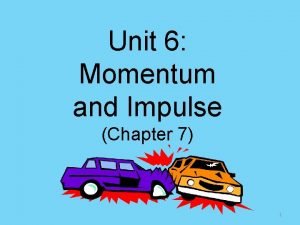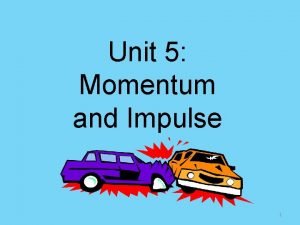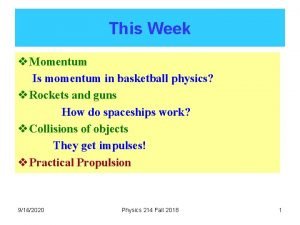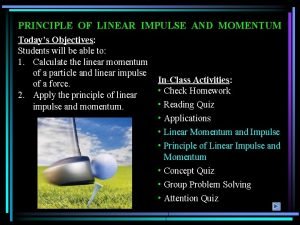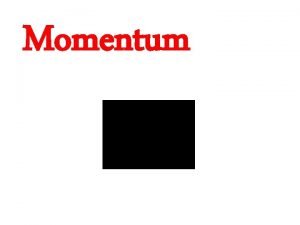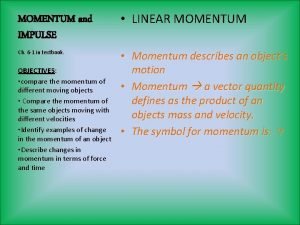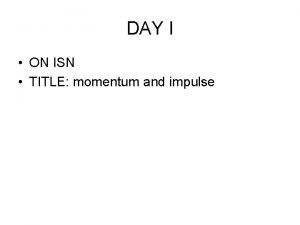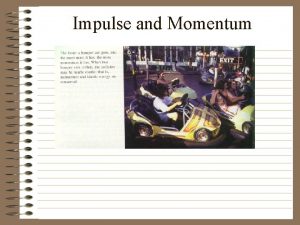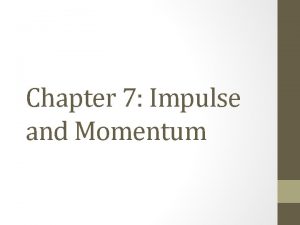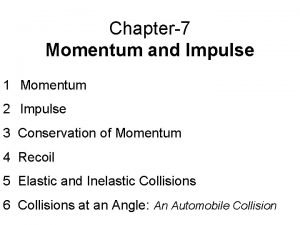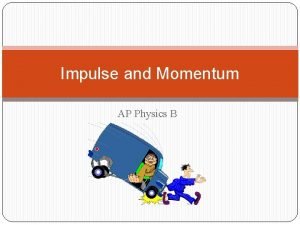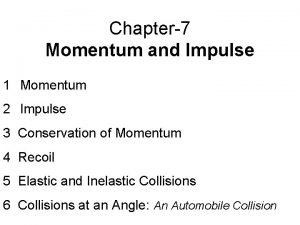Momentum and Impulse Momentum What is Momentum Mass










- Slides: 10

Momentum and Impulse

Momentum • What is Momentum? • Mass in Motion • Momentum is the product of mass and velocity • Measured in kg • m/s or kilogram meters per second • p is momentum in equations • What makes an object difficult to stop? • The more mass, its harder to stop • The more velocity, its harder to stop • p = mv • What is a vector? • BOTH Magnitude and Direction • Momentum can be + or - depending on coordinate system

Check for Understanding What is the momentum of a bee that has a mass of 10 grams and flies down at 2 m/s? 10 g=0. 01 kg (Conversion) p=mv=0. 01 kg x -2 m/s= -0. 02 kgm/s What is the momentum of a turtle that has a mass of 1 kg and moves at 0. 05 m/s right? p=mv=1 kg x 0. 05 m/s= 0. 05 kgm/s Which one has a greater momentum? The bee or the turtle? The turtle has more momentum (larger magnitude).

Impulse What is impulse? Change in momentum caused by a force exerted over a time interval J is impulse in the equations J = FΔt J=Δp What changes in momentum equation? Velocity Δp= mΔv

Check for Understanding A bowling ball of 10 kg moving at 3 m/s bowls through a set of bowling pins. Right before the ball falls down the shoot it is going 2 m/s What is the impulse the bowling pins provide to a bowling ball? J = mΔv J = m*(V final – V initial) J = 5*(2 -3)=-5 kgm/s This shows that the force was in the negative direction and slowed down the ball In soccer, a penalty kick with the soccer ball is initially at rest. The soccer ball, 300 g, is kicked at 25 m/s. The player's foot was in contact with the ball for 0. 1 seconds. What was the impulse on the ball? Find the Average Force 300 g=. 3 kg (Conversion) J = mΔv = m*(V final-V initial)=. 3*(25 -0) = 7. 5 kgm/s J = FΔt 7. 5 = F * 0. 1 F= 75 N

Impulse-Momentum Theorem

Lab Discussions

Types of Collisions Remember When when momentum is conserved outside forces are balanced pi=pf Two scenarios of collision in carts Elastic Cart Collison 1 hits Cart 2 -> Both Carts REPEL each other m 1 iv 1 i+m 2 iv 2 i= Inelastic m 1 fv 1 f+m 2 fv 2 f Collision Cart 1 hits Cart 2 -> Cart 1 and Cart 2 Masses ATTRACT (STICK) with each other m 1 iv 1 i+m 2 iv 2 i =(m 1+m 2)vf

Momentum Bar Chart Representation 1. Write down all scenarios for initial and final situations. 2. Designate objects in the system by listing the object, its mass, and its velocity in the chart -- use variables for unknown quantities. 3. Draw a horizontal bar to represent the size and direction of the momentum for each object. 4. Write the conservation of momentum equation for the bars 5. Solve for the unknown quantity.

Momentum Bar Chart Representation Practice A 800 kg car with a speed of 20 m/s and a 500 kg car with a speed of 16 m/s collide together. When they collide, the two cars stick together. Determine the velocity of the cars (magnitude and direction)immediately after the collision
 Physics 03-02 potential energy and conservative forces
Physics 03-02 potential energy and conservative forces Unit 6 momentum and impulse
Unit 6 momentum and impulse Unit of momentum and impulse
Unit of momentum and impulse Basketball impulse and momentum
Basketball impulse and momentum Linear impulse momentum equation
Linear impulse momentum equation Linear impulse
Linear impulse Importance of momentum and impulse
Importance of momentum and impulse Poem about momentum and impulse
Poem about momentum and impulse Which has a greater momentum a truck with a mass of 2250 kg
Which has a greater momentum a truck with a mass of 2250 kg Importance of momentum and impulse
Importance of momentum and impulse Momentum and impulse formula sheet
Momentum and impulse formula sheet

